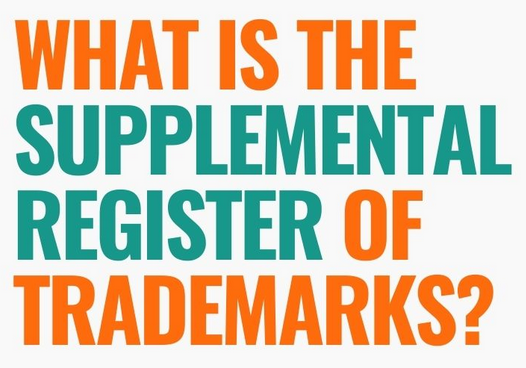Your cart is empty now.

USPTO Supplemental Register for a Trademark
- 09 April, 2024
- Nyall Engfield
USPTO Supplemental Register
The United States Patent and Trademark Office (USPTO) maintains two separate registers for trademarks: the Principal Register and the Supplemental Register. While the Principal Register is often the primary goal for trademark applicants due to its broad protections, the Supplemental Register provides a viable alternative for marks that do not initially qualify for the Principal Register, typically because they are descriptive, geographically descriptive, a surname, or otherwise not inherently distinctive but are capable of acquiring distinctiveness (secondary meaning) over time.
Understanding the Supplemental Register
The Supplemental Register is intended for trademarks that are in use in commerce but do not yet meet the criteria for registration on the Principal Register. Registration on the Supplemental Register allows the trademark owner to use the registered trademark symbol (®), which can deter potential infringers and signal that the trademark is legally protected.
Pros of the Supplemental Register
-
Federal Recognition: Trademarks on the Supplemental Register receive federal recognition, which can be a significant advantage in infringement litigation.
-
Use of the ® Symbol: Registrants can use the registered trademark symbol, which can deter potential infringers and signal the trademark's protected status.
-
Access to Federal Courts: Trademark owners with registrations on the Supplemental Register can bring infringement lawsuits in federal court.
-
Basis for Foreign Registration: A Supplemental Registration can serve as a basis for registering the trademark in certain foreign countries.
-
Customs Protection: Registrants can record their trademarks with U.S. Customs and Border Protection to help prevent the importation of infringing goods.
-
Time to Acquire Distinctiveness: Being on the Supplemental Register gives a mark time to acquire the secondary meaning necessary for eventual transfer to the Principal Register.
Cons of the Supplemental Register
-
Limited Legal Protections: Unlike the Principal Register, the Supplemental Register does not confer a presumption of the registrant’s ownership of the mark or the exclusive right to use the mark nationwide on the goods/services listed in the registration.
-
No Constructive Notice: Registration on the Supplemental Register does not provide constructive notice to others that the registrant claims ownership of the mark, which is a significant benefit of the Principal Register.
-
Cannot Become Incontestable: Marks on the Supplemental Register cannot achieve incontestable status, a powerful protection against challenges to the validity of the registration available to marks on the Principal Register after five years.
-
Ineligibility for Certain Damages: Owners of marks on the Supplemental Register may not be eligible for certain statutory damages in infringement suits that are available to owners of marks on the Principal Register.
-
Limited Deterrent Effect: The perception of lesser protection may make a Supplemental Registration less of a deterrent to potential infringers compared to a Principal Registration.
When to Consider the Supplemental Register
The Supplemental Register is an excellent option for trademarks that are not inherently distinctive but are still in use in commerce. It provides a way for these marks to gain some federal protection while they work on acquiring the necessary distinctiveness for the Principal Register. It's particularly useful for new businesses or products that are building brand recognition.
Transitioning to the Principal Register
A significant advantage of starting on the Supplemental Register is the ability to later transfer to the Principal Register. After a mark has been in use for a sufficient period (typically five years), and evidence can be provided that the mark has acquired distinctiveness, the trademark owner can file a new application for the Principal Register.
Increased Weight for Supplemental Registrations
Practically speaking, the weight placed by the USPTO on Supplemental Registrations has increased in the past two or three years with the desire of the USPTO to decrease the number of registrations in the system. I have personally noticed a many-fold increase in the citations of Supplemental Registrations against trademark applicants. Examiners are citing marks on the Supplemental Register with much greater authority and holding them to higher distinctiveness than previously.
Conclusion
The Supplemental Register offers a strategic option for trademark protection in the United States, particularly for marks that are not initially eligible for the Principal Register. While it comes with limitations, especially regarding the legal protections afforded, it still provides significant benefits, including federal recognition and the ability to use the registered trademark symbol. For many businesses, these benefits make the Supplemental Register an attractive option as they build the distinctiveness of their marks. Ultimately, the choice between aiming for the Principal or Supplemental Register should be made with a clear understanding of the trademark's current strength, the business's strategic goals, and the potential for the mark to acquire distinctiveness over time.



